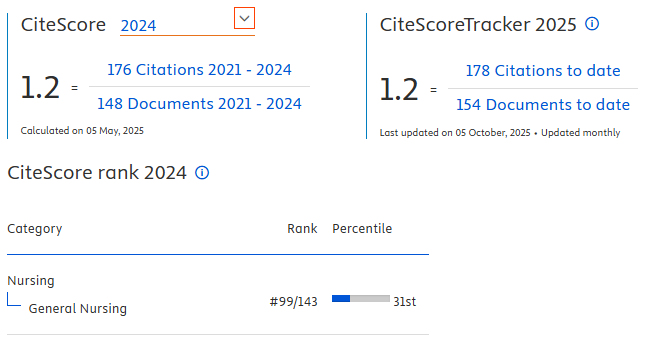Influence Factors of Emergency Medical Services (EMS) Prehospital Time Interval Variety: A Systematic Review
Downloads
Introduction:Prehospital time interval was one of important indicators of EMS performance. It consisting of total prehospital time (TPT), response time (RT), on-scene time (OST) and transport time (TT) in the world is very diverse. Many factors were able to affect the duration of prehospital time. The purpose of this systematic review was to identify internal and external EMS factors that affect prehospital time which was useful as a predictor of the prehospital time interval variety.
Methods: This study was conducted with a systematic method by reviewing the literature obtained from four electronic databases namely ProQuest, PubMed, ScienceDirect, and Google Schoolar. Seven keywords were used to get some of relevance literatures. Using PRISMA flow diagram, the literatures were screened by three inclusion criteria: original research article, published in the 2007-2018 timeframe, discusses EMS prehospital time interval and the factors that influence it.
Results: Seventy-five literature were obtained, of which 14 articles met the requirements for analysis. Factors influencing prehospital time variations can be classified as two. First, internal factors which include: facilities and infrastructure, human resources, and service protocols. Second, external factors which include: natural and non-natural environment, and the patient's clinical condition.
Conclusion: Investigation at prehospital time intervals and influential factors is useful in developing evidence-informed in assessing EMS performance and correcting the obstacles found. This review also identifies the gaps in the existing literature to inform future research efforts.Al-Shaqsi , S. Z. K. (2010). Respon time as a sole performance indicator in EMS : Pitfalls and solutions. Open Access Emergency Medicine, 2, 1-6.
Brown, J. B., Rosengart, M. R., Forsythe, R. M., Reynold, B. R., Gestring, M. L., Hallinan, W. M., . . . Sperry, J. L. (2016). Not All Prehospital Time is Equal: Influence of Scene Time On Mortality. J Trauma Acute Care Surgery, 81(1), 93-100. doi: 10.1097/TA.000000000000099
Davies, H. T. O., & Crombie, I. K. (2001). What is a Systematic Review (Vol. 1). UK: Hayward Medical Communications.
Do, Y. K., Foo, K., Ng , Y. Y., & Ong , M. E. H. (2013). A QUANTILE REGRESSION ANALYSIS OF AMBULANCE RESPONSE TIME. Prehospital Emergency Care, 17, 170-176. doi:
3109/10903127.2012.729127
Fleischman, R. J., Lundquist, M., Jui, J., Newgard, C. D., & Warden, C. (2013). Predicting Ambulance Time of Arrival to the Emergency Department Using Global Positioning System and Google Maps. Prehospital Emergency Care, 17(4), 458-465. doi: 10.3109/10903127.2013.811562.
Golden, A. P., & Odoi, A. (2015). Emergency medical services transport delays for suspected stroke and myocardial infarction patients. BMC Emergency Medicine, 15(34). doi: 10.1186/s12873-015-0060-3
Gonzalez, R. P., Cummings, G. R., Phelan, H. A., Mulekar, M. S., & Rodning, C. B. (2009). Does Increas emergency medical services prehospital time affect mortality in rural motor vehicle crashes? A statewide Analysis. The American Journal of Surgery, 197, 30-34. doi: 10.1016/j.amjsurg.2007.11.018
Katayama, Y., Kitamura, T., Kiyohara, K., Sado, J., Hirose, T., Matsuyama, T., . . . Shimazu, T. (2019). Prehospital factor associated with death on hospital arrival after traffic crash in Japan: a national observational study. BMJ Open, 9(e025350). doi: 10.1136/bmjopen-2018-025350
Khorazani-Zavareh, D., Mommadi, R., & Bohm, K. (2018). Factors influencing pre-hospital care time intervals in Iran: a qualitative study. J inj Vieolence Res, 10(2), 83-90. doi: 10.5249/jivr.v10i2.953
Kitamura, T., Iwami, T., Kawamura, T., Nishiyama, C., Sakai, T., Tanigawa-Sugihara, K., . . . Hiraide, A. (2014). Ambulance calls and prehospital transportation time of emergency patients with cardiovascular events in Osaka City. Acute Medicine & Surgery, 1, 134-144. doi: 10.1002/ams2.25
Lam, S. S. W., Nguyen, F. N. H. L., Ng, Y. Y., Lee, V. P.-X., Wong, T. H., Fook-Chonge, S. M. C., & Ong, M. E. H. (2015). Factors affecting the ambulance response times of trauma incidents in Singapore. Accident analysis and prevention, 82, 27-35. doi: http://dx.doi.org/10.1016/j.aap.2015.05.007
Lin, C.-S., Chang, H., Shyu, K.-G., Liu, C.-Y., Lin, C.-C., Hung, C.-R., & Chen, P.-H. (1998). A Method to Reduce Response Times in Prehospital Care: The Motorcycle Experience. American Journal of Emergency Medicine, 16(7), 711-713.
Nagata, I., Abe, t., Nakata, Y., & Nanako, T. (2016). Factors related to prolonged on-scene time during ambulance transportation for critical emergency patients in a big city in Japan: a population-based observational study. BMJ Open, 6(e009599). doi: 10.1136/bmjopen-2015-009599
Nehme, Z., Andrew, E., & Smith, K. (2016). Factors Influencing the Timeliness of Emergency Medical Service Response to Time Critical Emergencies. Prehospital Emergency Care, Early Online, 1-9. doi: http://dx.doi.org/10.3109/10903127.2016.1164776
Paravar, M., Hosseinpour, M., Mohammadzadeh, M., & Mirzadeh, A. S. (2014). Prehospital Care and In-hospital Mortality of Trauma Patients in Iran. Prehosp Disaster Medicine, 29(5), 1-5. doi: 10.1017/S1049023X14000879
Puolakka, T., Kuisma, M., Lankimaki, S., Puolakka, J., Hallikinen, J., Rantanen, K., & Lindsberg, P. J. (2016a). Cutting the Prehospital On-Scene Time of Stroke Thrombolysis in Helsinki. Stroke, 47, 3038-3040. doi: 10.1161/STROKEAHA.116.014531
Puolakka, T., Vayrynen, T., Erkkila, E.-P., & Kuisma, M. (2016b). Fire engine support and On-scene time in prehospital stroke care - A prospective observational study. Prehospital and Disaster Medicine, 31(3). doi: 10.1017/S1049023X16000303
Rahman, N. H., Tanaka, H., Shin, S. D., Yih, Y. N., Piyasuwankul, T., Lin, C.-H., & Ong, M. E. H. (2015). Emergency medical services key performance measurement in Asian cities. International Journal of Emergency Medicine, 8(12). doi: 10.1186/s12245-015-0062-7
The Joanna Briggs Institute (Producer). (2017a, 1 Februari 2019). The Joanna Briggs Institute Critical Appraisal Tools for use in JBI Systematic Review. Checklist for Analytical Cohort Studies. Retrieved from http://joannabriggs.org/research/critical-appraisal-tools.html
The Joanna Briggs Institute (Producer). (2017b, 1 Februari 2019). The Joanna Briggs Institute Critical Appraisal Tools for use in JBI Systematic Review. Checklist for Analytical Cross Sectional Studies. Retrieved from http://joannabriggs.org/research/critical-appraisal-tools.html
The Joanna Briggs Institute (Producer). (2017c, 1 Februari 2019). The Joanna Briggs Institute Critical Appraisal Tools for use in JBI Systematic Review. Checklist for Analytical Qualitative Research. Retrieved from http://joannabriggs.org/research/critical-appraisal-tools.html
van Der Velden, M. W. A., Ringburg, A. N., Berg, E. A., Steyerberg, E. W., Patka, P., & Schipper, I. B. (2008). Prehospital interventions: Time wasted or time saved? An observational cohort study of management in initial trauma care. Emergency Medical Journal, 25, 444-449. doi: 10.1136/emj.2007.052662
Vincent-Lambert, C., & Mottershaw, T. (2018). Views of emergency care providers about factors that extend on-scene time intervals. African Journal of Emergency Medcine, 8, 1-5. doi: 10.1016/j.afjem.2017.08.003
Authors who publish with Jurnal Ners agree to the following terms:
- Authors transfer the Copyright and grant Jurnal Ners the right of first publication with the work simultaneously licensed under a Creative Commons Attribution 4.0 International License that allows others to remix, adapt and build upon the work with an acknowledgment of the work's authorship and of the initial publication in Jurnal Ners.
- Authors are permitted to copy and redistribute the journal's published version of the work (e.g., post it to an institutional repository or publish it in a book), with an acknowledgment of its initial publication in Jurnal Ners.
Jurnal Ners requires a formal written declaration and transfer of copyright from the author(s) for each article published. We, therefore, ask you to complete and return this form, retaining a copy for your own records. Your cooperation is essential and appreciated. Any delay will result in a delay in publication. The form can be downloaded HERE.
































